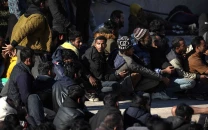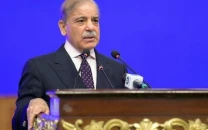Machetes vs machine guns: Rohingya salvation army outgunned in Myanmar
Myanmar says it killed around 400 Rohingya fighters and lost just 15 personnel since August 25

Ata Ullah, who has been identified by analysts and local people as the leader of Rohingya Muslim insurgency Arakan Rohingya Salvation, is seen on a laptop screen during a Skype interview with Reuters in Yangon Myanmar. PHOTO: REUTERS
Social-media savvy and believed to be backed by overseas emigres, the Arakan Rohingya Salvation Army (ARSA) appears to have significantly grown in the last year despite remaining hopelessly outgunned against one of Asia's largest militaries.
"I didn't want my children to become orphans," the 27-year-old told AFP this week from a refugee camp in Bangladesh as he explained why he deserted the group two weeks ago.
"They had some sticks, machetes and two guns for nearly 100 recruits. I realised I would simply die if I went to war with just a piece of wood," he said, giving his nom de guerre (an assumed name).
Myanmar villages burn as Rakhine unrest rages
Better-known locally as Harakahal Yaqin (Faith Movement), ARSA is locked in a David-and-Goliath battle. It announced its arrival last October with deadly ambushes on Myanmar border posts in Rakhine state, which has long been the seat of religious tensions between Muslims and Buddhists.
Notorious for its scorched earth counter-insurgency tactics, Myanmar's army - the Tatmadaw - responded with predictable ferocity.
More than 200,000 Rohingya have fled to Bangladesh since October bringing with them accounts of murder, rape and burned villages at the hands of the military. A fresh refugee exodus was sparked by another series of coordinated night-time raids by ARSA militants on August 25.
Analysts say those ambushes, which struck more than 30 places, were a tactical failure - the militants appeared to suffer heavy casualties and did not capture a significant number of guns.
But they showed that ARSA's ranks had swelled, helped by the brutal response of Myanmar's military. The group "has displayed a significantly improved capacity for coordinating operations over a wide area and is now able to mobilise far larger numbers of fighters," Anthony Davis, a regional security expert at Jane's IHS Markit, told AFP. "All the Tatmadaw abuses heaped on the population since October appear essentially to have fanned a popular revolt."
Statements by Myanmar authorities in the last two weeks describe ARSA fielding upwards of 150 fighters during dozens of skirmishes. But even if they have the numbers to be taken seriously, they lack the modern weapons to back it up.
Nearly 90,000 Rohingya escape Myanmar violence as humanitarian crisis looms
According to statements and photos released by Myanmar's army, the militants use primitive weapons, including gunpowder rifles, homemade guns and bombs as well as clubs and swords. In contrast, Myanmar's army is one of the best funded in Asia. Some 4.5 percent of GDP is devoted to the army budget, three times what the military gets even in junta-run Thailand.
Myanmar says it has killed around 400 Rohingya fighters and lost just 15 personnel since August 25 - although the army often plays down its casualties. Interviews with refugees and former fighters in Bangladesh suggests the uneven fight is taking its toll on ARSA with a noticeable increase in men of fighting age among refugee arrivals the last few days.
Ala Uddin secretly left his family in Myanmar's Rathedaung town ship five months ago to join ARSA. "We were trained to fight with bravery in our hearts," he said, adding he received instruction in how to plant explosives and fire rifles. But he soon realised that the assaults they ended up carrying out were "pointless attacks" with "ancient weapons", so he deserted.
Mohammed Akbar, an 18-year-old refugee who arrived in Bangladesh this week, said school friends had died fighting alongside ARSA. "They barely have any proper weapons. So I chose to escape," he said.
The Rohingya had largely eschewed violence until ARSA appeared. Little is known about who runs or finances the group. A report by the International Crisis Group based on interviews with members, said the militants answered to a leadership committee of wealthy Rohingya emigres in Saudi Arabia. They set up the group in 2012 after anti-Muslim riots swept through Rakhine.
Its most visible face is on-the-ground commander Ata Ullah. He was reportedly born to a Rohingya family in Karachi, Pakistan, before moving to Saudi Arabia - a theory backed up by the confident Rohingya and Peninsular Arabic he speaks in ARSA's videos. In recent months they have ramped up their social media presence, including a Twitter account (@ARSA_Official) that is often the first to publish ARSA statements or direct readers to videos.
STATEMENT: Burmese Terror Army Committing War Crimes, Genocide & Crimes against Humanity against #Rohingya
— ARSA_The Army (@ARSA_Official) September 6, 2017
ARSA Welcomes #IFFM to Arakan pic.twitter.com/Afmz64eUrG
Ata Ullah starts his statements with Islamic greetings. But the group has not made any public pledges of fealty to major jihadist groups. Instead ARSA portrays itself as one of Myanmar's many ethnic rebel insurgencies fighting an abusive central military.
"There has been an attempt to reach out to the wider international community, an effort to stress the fact that they are not jihadists, but an ethno-nationalist movement with a cause," said Davis. In interviews, Ata Ullah has rejected the terrorist label and said his group does not target civilians. But Myanmar says the group has murdered Buddhist civilians.
Suu Kyi, Myanmar face chorus of anger over atrocities against Rohingya Muslims
Analysts also blame them for a wave of assassinations in remote Rakhine villages of perceived state collaborators in recent months. Zachary Abuza, an expert on Southeast Asian militant groups, said ARSA had caught the attention of international jihadists. "Whether these guys are actively courting this support or they want it, it might well happen anyway," he said.
Indonesian police, he said, have stopped two plots to blow up Myanmar's embassy in Jakarta and Malaysia has arrested militants who were trying to reach Rakhine. The scorched earth response from Myanmar's military has also created a huge pool of angry Rohingya refugees ripe for recruitment. "It's like watching a train wreck in slow motion," he said.



















COMMENTS
Comments are moderated and generally will be posted if they are on-topic and not abusive.
For more information, please see our Comments FAQ